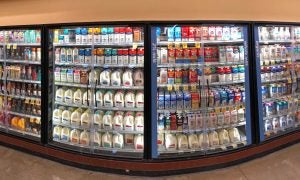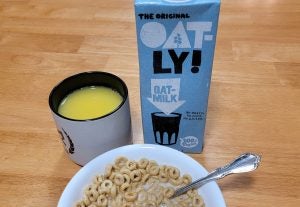I pursed my lips in skepticism as I read the headline from a dairy organization’s email blast: Plant based milk going down in flames!
The reason for that statement, according to the research presented in the email, was that the retail-sales volume of plant-based beverages year-over-year has been negative since February, continuing a trend of flat-to-declining volume that dates to mid-2021.
For all of the dairy and milk-alternative habits that may have changed with the rise of COVID-19, the National Milk Producers Federation was now suggesting that things were finding new balance as the United States puts many pandemic-related supply-chain limitations in the rearview mirror.
So maybe this isn’t a good time to mention that plenty of other 2022 sources say things akin to: “The plant-based milk industry continued to grow and thrive over the course of the past year. With consumers opting for dairy alternatives, many of these milks have become mainstream.” It currently clocks in at a roughly $2.3 billion industry.
So, which is it?
The circumstances in the dairy vs. plant-based debate are undoubtedly complicated, and I believe that part of the milk federation’s point was that current data show a pullback on milk-alternative consumption (even if “down in flames” is an over-the-top phrasing and encourages complacency about the competitiveness of the market). Much of the plant-based industry’s lofty five- and 10-year projections are rooted in sales data that go through 2020 or 2021, when such beverages were seeing their biggest boons ever. It adds context to why analysts forecast an 11 percent or 15 percent compound annual growth rate (CAGR), based on those pandemic numbers.

Yet the pandemic years had been anything but ordinary — it would be ridiculous to use 2020 and 2021 data for projecting job markets, health-care costs, or entertainment revenue across the next decade. So why should the public rely on data from that era to evaluate their eating habits, too?
Isn’t it more likely that we’re seeing plant-based beverage companies capitalizing off of the pandemic snapshot — a clear outlier — and using those figures to portray greater market advantages? After all, many of the comparisons that castigate dairy’s sales trends focus almost exclusively on fluid dairy consumption, not the whole of dairy products and the industry. Factoring in cheese, butter, and other related products, U.S. farm income from dairy rose from $31.4 billion in 2010 to $40.5 billion in 2019, just before the pandemic hit. The U.S. Department of Agriculture also shows that in that same span, annual consumption of dairy products rose from 603 pounds per person to 652 pounds per person.
And extending both of those metrics, dairy continued to improve throughout the pandemic. With new USDA data about to be released, all signs even point to per capita dairy consumption rising for the seventh time in eight years.
The message from dairy should be affirmative for its products, not retributional toward the competition.
The population of the world is growing — food-production sectors talk about it constantly, as do transportation and energy sectors. There is room here for both real dairy and plant-based alternatives to advance and grow.
Milk is embraced in most modern diets because of its 13 essential nutrients, such as protein, calcium, phosphorus, vitamin A, vitamin D, riboflavin (B2), and niacin (B3). Certain types of alternatives — such as soy, oat, pea, and almond/cashew — that have long fallen short nutritionally have been innovating by adding protein and other nutrients to their blends since the pandemic and have begun to deliver stronger comparisons to real milk.

Still, both sides of this spurious beverage war are financially succeeding, even though individual companies may be struggling. For example, oat milk is the fastest-growing milk-alternative variety, yet one of the most well-known manufacturers, Oatly, has seen its stock plummet more than 80 percent since summer 2021, partly due to the juvenile and obnoxious 2021 Super Bowl ad its CEO released that turned many people off from the brand.
Sensationalism has a way of doing that. Sensationalism can take a short-term emotional reaction and create a long-term fiscal fumble. Sensationalism is, simply, senseless for a product-based business to embark on.
The “dairy is dying” mantra has been regurgitated by critics for years. Now we’re told that we’re in the midst of a “plant-based beverage bust.” With nationwide efforts to make a growing number of consumers more and more food secure, I’m not sure either of these alliterative angles see what I’m seeing.
Ryan Tipps is the founder and managing editor of AGDAILY. The Virginia Tech graduate has covered farming since 2011, and his writing has been honored by state- and national-level agricultural organizations.



